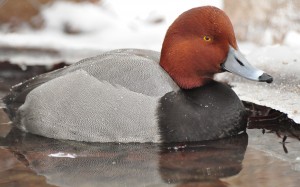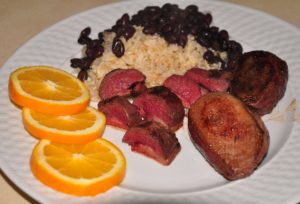Photography courtesy of Lowell Washburn, all rights reserved.
Across Iowa’s northern tier, the signals are clear. This year’s duck season is rapidly winding down. Smaller ponds and sloughs – even the larger marshes — are completely iced over – have been that way for more than a week now. Winter is at hand and even the largest lakes are on borrowed time.
But for those who hunt diving ducks, there was still time for one last hoorah before final freeze up sealed food supplies and chased the last bluebill, canvasback, and redhead out of the country.
Hunting end of the season divers is stern business; complete with dangerous weather conditions, frozen fingers, and iced up decoys. But when things go right, previous hardships quickly become minor.
Next to the regal canvasback, redheads are my favorite species of diving duck. Redheads are big, beautiful, and they come to decoys like nobody’s business – I was reminded of that this morning when a flock of a dozen or so came roaring into the decoys at daybreak. Redhead ducks also provide delicious table fare – so much so, in fact, that during the heyday of the market gunning era, upscale East Coast restaurants [after selling out of canvasback] sometimes substituted celery fed redhead in place of the famed King of Ducks. Customers were never the wiser. The best part of the story is that redheads are as delicious today as they were during the late 1800s.
This year, redheads stayed in the north longer than usual. Across Northern Iowa – all the way from the Upper Mississippi River to Okoboji – rafts containing 300, 500, or even more birds could still be observed into late November.
Collecting a brace of fat, full plumage drake redheads is always a stellar moment in waterfowling. Once they’re plucked and singed, I prefer to age my redheads. Eight to ten days at 35 degrees is just about right. Once aging is complete, I usually slow cook the birds over a combination of charcoal and apple wood. They can also be passed through a hot [400 degree] oven until medium rare and served with a side of wild rice or bread dressing.
Occasionally, I like to try something different – pan seared redhead is one of my favorites. For this dish I simply dismantle the plucked duck and season with Cajon spices – or you can use whatever is your personal favorite. Heating a skillet [the heavier the skillet the better] to high temperature, I place the seasoned duck pieces skin side down and cook for about 4 to five minutes. I then turn and cook for another 4 minutes – times will vary with temperature and cookware. [You can employ a variety of oils, just make sure that whatever you use can hold up to the heat. If you have rendered duck or goose fat; always use that. Duck fat not only imparts a mild flavor to the entrée but also provides incredible stability under extreme heat.] To insure maximum tenderness and optimum flavor, pan seared duck should always be served rare. I realize that it’s hard for many people to eat anything but ducks that are cooked to well done; which is the exact reason that many people don’t like duck. Wildfowl are red meat. You should be cooking your duck the same way you would fix a ribeye.
LW




 Tom Cope
Tom Cope Sue Wilkinson
Sue Wilkinson Susan Judkins Josten
Susan Judkins Josten Rudi Roeslein
Rudi Roeslein Elyssa McFarland
Elyssa McFarland Mark Langgin
Mark Langgin Adam Janke
Adam Janke Joe Henry
Joe Henry Kristin Ashenbrenner
Kristin Ashenbrenner Joe Wilkinson
Joe Wilkinson Dr. Tammy Mildenstein
Dr. Tammy Mildenstein Sean McMahon
Sean McMahon